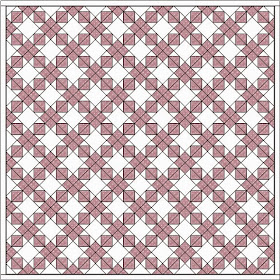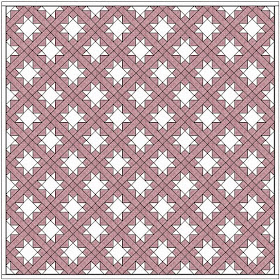Star by Becky Brown
A foulard print in the center square and
red points contrasted with a tossed floral.
Rather than focusing on color and dyes for a while we'll look at print style. Foulard-style prints were particularly popular for clothing in the 1860s.
Bettina Havig
Foulard or offset prints in both star and background.
Vintage top about 1840-1860.
The two simple madder reds on the left are figures printed in an offset repeat.
Classic 1860s fashion
These dresses may be printed wools---delaines.
The off-the-shoulder look above means
she's still considered a girl rather than a woman
A similar girl's dress
Another way to describe the set style is an isolated figure in a half drop repeat
There are many terms for the staggered repeat.
When the figure is circles we call them Polka Dots.
Vintage quilt, 1850-1870
We see a lot of foulard sets in the printed wools of the mid-19th-century.
Vintage cotton quilt, 1850-1880
Vintage quilt, mid-19th century
Vintage quilt, mid-19th century, found in Minnesota Project.
Picture from the Quilt Index.
Patatelier on her blog:
"I never saw a foulard I didn't like."
The exaggerated print scale and pose may
mean this is an actress in a stage costume.
Reproductions
Here's a little repro quilt Jan Schultz did in 2008,
bordered with a madder-style foulard.
I have a new collection for Moda called Alice's Scrapbag, coming out as yardage in September, 2015.
Alice had many foulard-style prints in her 1850s scrapbag, including this paisley cone. The original is on the left; the redder one is the reproduction.
See more about the collection and its foulards here:
Two of my older repro prints in madder-style shades.
Above and below from Circa 1825 collection by In the Beginning
A classic green from Judie Rothermel's New Colonies
Foulard from Red Rooster
The offset figures can really catch your eye. In Marsha McCloskey's star
quilt the blue off-set print should be background but dots demand your attention.
The latest Collection for a Cause with two classic foulards.
Ann contrasted two foulards with a seaweed or coral repeat in the background
for her North Star.
Valerie used a foulard for the background and a tossed paisley for the red.
A tiny quilt by Kathie Ratcliffe making good
use of foulard-style madders. Kathie really understands the
way seamstresses used fabric in the 19th century.
What To Do with Your Stack of Stars:
Set Them in Half Drop Fashion
Quilt dated 1864 by Octavia Lewis
Maine State Museum
The staggered repeat was so important to mid-century design that it was a favored set for quilt blocks too.
Vintage quilt, 1840-1880
Particularly in applique.
Set your star blocks on point to create a foulard-style set. I did some sketches in EQ7 using the On-Point Layout for 6" blocks.
Dark stars with light backgrounds set on point....
or light stars on dark backgrounds.
If you really want to emphasize the diagonal grid add sashing between the stars.
Dark stars on light backgrounds with 1-1/2" sashing
This is how Octavia Lewis got the look in the field of stars
behind her flag above.
1-1/2" sashing
(Proportion in the sashing is one quarter the block size here.)
The wider the sashing the more isolated the star.
3" sashing
Here's a sashing half the size of the blocks.
Insanity, pieced by Barb Heetland,
quilted by Judy Wehrspant, Milford, Iowa
Barb made 4-1/2" stars and set them
with alternate plain blocks. It's a different block but
when set like this it makes the same old-fashioned, diagonal grid.
Judy's machine quilting is terrific.
One More Thing About Foulard-style prints
Women modeling traditional French clothing.
National Geographic.
Foulard is a French word that has come to mean not only the print style but clothing traditionally made from the patterned fabric.
A foulard-style necktie.
In recent decades foulards came to define the "Preppy look."
So---are you going to make a box labeled Foulards
where you keep these spotty prints sorted by style rather than color?
For more about foulards see my book America's Printed Fabric, pages 68-71.
And a post about foulards in a Civil-War-era stash.
http://barbarabrackman.blogspot.com/2009/12/document-and-reproduction-prints.html
More about earlier foulard styles:
http://quilt1812warandpiecing.blogspot.com/2012/02/imported-prints-indiennes-mignonettes.html









.jpg)



.JPG)




























I've never hear that term before - and I have so many of them. Great theme for this week.
ReplyDeleteIt was great to meet you and hear your talk in NYC last Saturday.
Looking forward to Alice's Scrapbag - love the reds and purples!
ReplyDeleteOff to ferret out some foulards :)
I've got this one covered! I don't think I'll be re-arranging my fabric though. :) Great post today!
ReplyDeleteThe photo of the girl with the cocker spaniel is my new favorite 19th C picture. Thanks for the long and fascinating post. I hope those are your shoes! Perhaps a gift from Moda to all their designers?
ReplyDeleteI'm with Lori. I have far too many to re-arrange. Can't wait for Alice's Scrapbag though! Thanks Barbara!
ReplyDeleteHello Barbara ! I'm french and I'm so proud to make your stars every week !!
ReplyDeleteCan I associate the fabric "foulard" with Provençal fabric please ? Because in the South of France, there is a fabric like this and of course, I have some !
Thank you in advance for your answer !
Cecile---there will be other posts on Indiennes and Provencal prints too. Very French.
ReplyDeleteYes ! I have read them ! Thank you very much !!
ReplyDeleteI had always avoided "dotty spotty", preferring more organic fabric designs, such as vines and paisleys. Now that I know they are "foulards", they are much more appealing. Thanks! Cwoosley12@yahoo.com
ReplyDeleteIt just dawned on me; these must be "Fool-ards" for April Fool's Day! What fun!
ReplyDeleteAh Vic---I'm not that clever at puns.
ReplyDeleteBut a belated April Foulard Day to you.
The antique red and green hickory reel applique with swag border noted for the half drop setting is part of the Sandra Starley Collection.
ReplyDelete